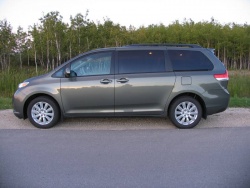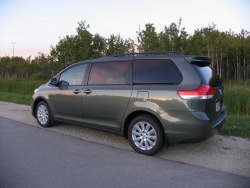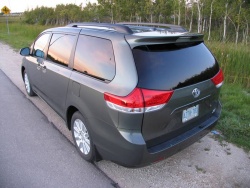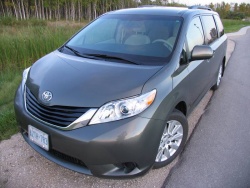 2011 Toyota Sienna LE AWD. Click image to enlarge |
|
Related articles on Autos
Manufacturer’s web site
|
By Haney Louka
Photo Gallery:
2011 Toyota Sienna
Toyota might just have this van thing figured out: there’s only so much you can do with a minivan. By definition, it needs to look like the box it came in, lest it lack the fundamental practical advantages it has over other vehicle types.
It’s easy to try too hard as well: just have a look at the 2011 Honda Odyssey with its droopy derriere to see what I mean. No matter what you do with the styling, it’ll still look like a van. So Toyota has accepted this truth, and come out with a tasteful evolution of the breed. While I can’t accuse them of trying too hard, it would be similarly unfair to say that they’re resting on their laurels. The Sienna includes such tasteful updates as more squared-off styling and LED taillights to inform others that there are hip folks behind the wheel.
And then there’s the advertising: one only needs to look up “swagger wagon” on YouTube to find the brilliance behind Toyota’s U.S. operations’ marketing efforts. Even though I’m not a van guy, I almost became one after watching those clips.
  2011 Toyota Sienna LE AWD. Click image to enlarge |
Starting at $27,900, the van is now available with a four-cylinder engine. It’s reported to be a decent unit, but those who routinely load their vans up with people and their stuff might find it a little wanting for oomph. It’s a good thing, then, that the Sienna V6 is just a small step up in price for a huge increase in power: the 187-hp four-banger gives way to a 266-horse V6 – the kicker is that the six-pot motor only consumes marginally more fuel in front-drive models. So the number side with the V6: 3.5 per cent increase in price, 42 per cent increase in power, 10 per cent increase in fuel consumption.
It’s no wonder then that the $28,900 Sienna V6 is expected to be the volume leader in the Sienna line. Standard equipment includes tri-zone manual temperature control, four-speaker audio with auxiliary input jack and satellite prep, a cabin air filter, second-row captain’s chairs, split-folding rear bench (curiously labelled “split & stow”, not to be confused with Chrysler’s “stow ‘n go”), power windows and locks with keyless entry, a convex conversation mirror in the overhead console, tilt and telescoping wheel, cruise control, and tire pressure monitoring.
The 3.5-litre unit sports variable valve timing and 245 ft-lb of torque, and transfers power to the front or all four wheels through a six-speed automatic with manual shift mode. Stability and traction control are standard. Where the four-banger could be described as merely adequate in the power department, the six-pot is almost certainly overkill. It’s smooth and powerful, though, and there’s nothing wrong with having a little extra power at the ready.
 2011 Toyota Sienna LE AWD. Click image to enlarge |
Our tester was the $35,350 LE AWD (the front-drive LE carries a sticker price of $32,500) and adds 18-inch alloys (17s are standard), six-speaker audio with Bluetooth connectivity and USB input and wheel-mounted controls, power driver’s seat, a back-up camera with 3.5-inch display (which helped me get into an impossibly tight parallel-parking spot downtown), dual power sliding doors, retractable second- and third-row window shades, and some cosmetic upgrades.
I would encourage buyers to consider the only all-wheel-drive van in the segment, because it offers that extra level of driving security for our winters. In fact, after the first snowfall of the season, I fulfilled my duty of providing as thorough a review as possible by switching the traction control off and doing a few tail-out corner exits. Sure, it may be odd to see a minivan fishtailing around the neighbourhood, but it was all in the interest of journalistic integrity. The point was to evaluate how power is distributed in slippery conditions, and whether the transfer of power to the rear wheels occurred in such a way as to maintain the balance of the vehicle; very important when probing the limits of traction. And in a nutshell, this one works.







 Follow Autos on Twitter
Follow Autos on Twitter



